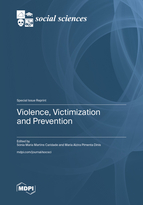Violence, Victimization and Prevention
A special issue of Social Sciences (ISSN 2076-0760). This special issue belongs to the section "Social Policy and Welfare".
Deadline for manuscript submissions: closed (31 July 2023) | Viewed by 37364
Special Issue Editors
Interests: domestic violence; dating violence; victims of polivictimization; youth and delinquency; gender-based violence
Special Issues, Collections and Topics in MDPI journals
Interests: violence and victimization; social sciences; global health; environment and human health; environmental science; sustainability; information and communication technologies (ICTs); statistics and probability
Special Issues, Collections and Topics in MDPI journals
Special Issue Information
Dear Colleagues,
This Special Issue aims to address violence as a serious public health problem (Rossi and Talevi, 2017) that entails several new forms of victimization stimulated by contemporary societies. Violence and victimization cross different cultures and different systems (e.g., individual, family, school, social) and subsystems (e.g., marital, parental, peers, dating), impacting different areas, such as health (physical and mental), criminal justice, and social wellbeing, and may undermine social development (WHO, 2014; Seth and Peshevska, 2014). Experiencing violence is a major risk factor for the development of lifelong health and social problems (Rossi and Talevi, 2017). Violence is a complex, multifaceted, and multidetermined phenomenon (Dahlberg and Krug, 2006) that on a daily basis victimizes the lives of many children, adolescents, adults, and the elderly, requiring continuous effort to achieve an adequate understanding of how it is carried out and how to minimize it and prevent it (Hamby, 2017). The articles in this Special Edition should address the different types of violence and new forms of victimization present in the various systems and subsystems above identified, as well as the prevention practices developed to mitigate their impact and implications in individual and social terms. Papers related with practical implications for clinical and institutional support to victims of violence are also welcome. Submitted papers should be based on rigorous, high-quality quantitative, qualitative, or mixed-methods research, intersectional and comparative analyses, contributing to new insights and developments into the topics addressed. Papers based on research with under-represented, minoritized or marginalized groups, or specific social contexts are particularly encouraged.
References
Dahlberg, L., & Krug, E. (2006). Violence a global public health problem. Ciência & Saúde Coletiva, 11(2), 277-292.https://doi.org/10.1590/s1413-81232006000200007
Hamby, S. (2017). On defining violence, and why it matters. Psychology of Violence, 7(2), 167-180. http://doi.org/10.1037/vio0000117
Rossi, A., & Talevi, D. (2017). Interpersonal violence and mental illness. Journal of Psychopathology, 23, 49-51.
Seth, D., & Peshevska, D. J. (2014). Preventing interpersonal violence in Europe. Macedonian Journal of Medical Sciences, 2(2), 350-352. https://doi.org/10.3889/oamjms.2014.060
World Health Organization (WHO). (2014). Global status report on violence prevention. World Health Organization.
Other important references
Ameral, V., Palm Reed, K. M., & Hines, D. A. (2017). An analysis of help-seeking patterns among college students victims of sexual assault, dating violence, and stalking. Journal of Interpersonal Violence, 1-25. https://doi.org/10.1177/0886260517721169
Caridade, S. (2019). Dating violence in schools: Preventing and responding through the perspective of educational professionals. In W. Spencer (Ed.), Dating Violence: Prevalence, Risk Factors and Perspectives (pp. 25-40). New York: Nova Science Publishers, Inc.
Caridade, S., Braga, T., & Borrajo, E. (2019). Cyber dating abuse: Evidence from a systematic review. Journal of Aggression and Violent Behavior, 48, 152-168. https://doi.org/10.1016/j.avb.2019.08.018
Caridade, S., Pinheiro, I., & Dinis, A. (2019). Disclosure in victims of dating violence: Strategies and reasons for help-seeking. In W. Spencer (Ed.), Dating violence: Prevalence, risk Factors and perspectives (pp. 85-106). New York: Nova Science Publishers, Inc.
Chu, D. C., & Sun, I. Y. (2014). Reactive versus proactive attitudes toward domestic violence: A comparison of Taiwanese male and female police officers. Crime and Delinquency, 60(2), 216-237. http://doi.org/10.1177/0011128710372192
De La Rue, L., Polanin, J., Espelage, D., & Pigott, T. (2017). A meta-analysis of school-based interventions aimed to prevent or reduce violence in teen dating relationships. Review of Educational Research, 87(1), 7-34. http://doi.org/10.3102/0034654316632061
Delara, M. (2016). Mental health consequences and risk factors of physical intimate partner violence. Mental Health in Family Medicine, 12, 119-125. Retrieved from http://www.mhfmjournal.com/pdf/mental-health-consequences-and-risk-factors-of-physical-intimate-partner-violence.pdf
Hagemann-White, C. (2017). Responses to domestic violence in Germany in a European context. In E. S. Buzawa & C. G. Buzawa (Eds.), Global responses to domestic violence (pp. 87-105). Cham, Switzerland: Springer. https://doi.org/10.1007/978-3-319-56721-1_5
Khubchandani, J., Clark, J., Wiblishause, M. et al. (2017). Preventing and responding to teen dating violence: A national study of school principals' perspectives and practices. Violence and Gender, 4(4), 144-151. https://doi.org/10.1089/vio.2017.0043
Lamoreaux, D., & Sulkowski, M. L. (2019). An alternative to fortified schools: Using crime prevention through environmental design (CPTED) to balance student safety and psychological well‐being. Psychology in the Schools, 1-14. http://doi.org/10.1002/pits.22301
Palermo, T., Bleck, J., & Peterman, A. (2013). Tip of the iceberg: Reporting and gender-based violence in developing countries. American Journal of Epidemiology, 179(5), 602-612. http://doi.org/10.1093/aje/kwt295
Park, S., & Kim, S. (2018). The power of family and community factors in predicting dating violence: A meta-analysis. Aggression and Violent Behavior, 40, 19-28. http://doi.org/10.1016/j.avb.2018.03.002
Santos, A. & Caridade. S. (2017). Violence in intimate relationship between same- sex partners: prevalence study. Trends in Psychology, 25(3), 1357-1371. http://doi.org/10.9788/tp2017.3-19pt
Sigurdsson, E. L. (2019). Domestic violence-are we up to the task? Scandinavian Journal of Primary Health Care, Online publication. https://doi.org/10.1080/02813432.2019.1608638
Smith, K., Cénat, J. M., Lapierre, L., Dion, J., & Hébert, M. (2018). Cyber dating violence: Prevalence and correlates among high school students from small urban areas in Quebec. Journal of Affective Disorders, 234, 220–223. https://doi.org/10.1016/j.jad.2018.02.043
Prof. Dr. Sónia Maria Martins Caridade
Prof. Dr. Maria Alzira Pimenta Dinis
Guest Editors
Manuscript Submission Information
Manuscripts should be submitted online at www.mdpi.com by registering and logging in to this website. Once you are registered, click here to go to the submission form. Manuscripts can be submitted until the deadline. All submissions that pass pre-check are peer-reviewed. Accepted papers will be published continuously in the journal (as soon as accepted) and will be listed together on the special issue website. Research articles, review articles as well as short communications are invited. For planned papers, a title and short abstract (about 100 words) can be sent to the Editorial Office for announcement on this website.
Submitted manuscripts should not have been published previously, nor be under consideration for publication elsewhere (except conference proceedings papers). All manuscripts are thoroughly refereed through a double-blind peer-review process. A guide for authors and other relevant information for submission of manuscripts is available on the Instructions for Authors page. Social Sciences is an international peer-reviewed open access monthly journal published by MDPI.
Please visit the Instructions for Authors page before submitting a manuscript. The Article Processing Charge (APC) for publication in this open access journal is 1800 CHF (Swiss Francs). Submitted papers should be well formatted and use good English. Authors may use MDPI's English editing service prior to publication or during author revisions.
Keywords
- child abuse
- dating violence
- domestic violence
- early prevention
- elderly abuse
- exposure to interparental violence
- family violence
- gender-based violence
- interpersonal violence
- intimate partner violence (IPV)
- marital violence
- multicultural intervention
- multiple victimization
- polyvictimization
- primary prevention
- psychoeducational intervention
- school violence
- secondary prevention
- secondary victimization
- singular victimization
- tertiary prevention
- violence and information and communication technologies (ICT’s)
- violence awareness
- violence prevention practices
- youth violence







